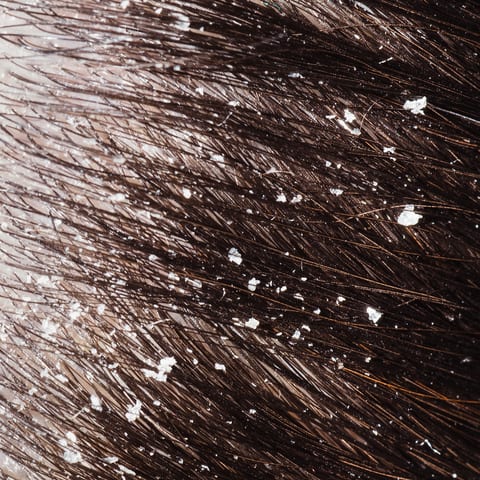Scalp Eczema
Scalp Eczema is an itchy, dry, inflamed scalp condition. Our treatment methods adopt a gentle but practical approach in controlling such a conditions. Most importantly, removing that irritating crusting because this in turn will then calm the underlying skin. This in turn slows the cell proliferation.The first step in any skin ailment is to confirm a diagnosis. At which point treatment either at home or in the clinic can be advised.
If you think you are suffering from scalp eczema or any itchy scalp condition then give us a call. We can offer advice on the phone or arrange a visit for you. Alternatively, send us an e-mail (contact page) with any questions you may have.
What is Scalp Eczema
Scalp Eczema are a group of non contagious acute or chronic scalp conditions characterised by erythema (inflammation), oozing, skin thickening, formation of papules, vesicles (blisters) and crust. Pruritis (itching, often severe) leads to self manipulation and bleeding because of the irresistible urge to scratch. A burning sensation often accompanies scalp eczema therefore you should seek advice to ensure you don’t make the condition worse. May affect all ages.
Secondary infection often occurs because of the broken skin. Scalp Eczema in most cases can be controlled, however it is not considered curable. Affected skin is likely to suffer to flare ups. SE is categorised into environmental and internal. Itchy Scalp – Scalp Eczema can make the scalp feel very uncomfortable, dry and itchy. An itchy scalp may be a symptom of scalp eczema or one of the many other dry scalp conditions that cause irritation, inflammation, cracking, bleeding and in some cases hair loss. An itchy scalp is the bodies immune system reacting to a problem therefore the skin becomes red and inflamed. If shampooing doesn’t help you should seek professional advice.
Registered with the The Trichological Society TTS
Environmental Scalp Eczema
(scalp conditions) – Irritant Contact Dermatitis/eczema, Allergic Contact Dermatitis/eczema and Herpeticum eczema. These are caused by the application of chemicals such as hair dyes and relaxing agents.
The list is extensive. Reactions such as these may result in hospitalisation therefore please seek advice.

Internal Eczema (scalp conditions)
Atopic Dermatitis/eczema, Seborrhoeic Dermatitis/eczema, Nummular Dermatitis/eczema, Dishydrotic/Pompholyx (blistering) Dermatitis/eczema, Varicose Eczema/dermatitis, Asteototic (dry)
Dermatitis/eczema, Madidans eczema, Pustulosum eczema and Rubrum eczema.
Phone Consultation
Why not give us a ring and speak with a trichologist right new? Its a free service that we offer in order to help you. It takes about 10 minutes. Just give us a call on the number above. Our phone lines are extremely busy so we might not be able to pick up right away. Leave your name and a number and we will call you back.
Consultation Scalp Eczema
You can arrange a visit at the clinic to speak with a trichologist in person who will examine your scalp and offer a diagnosis. In addition we will advise on the correct course of treatment if required. Fill in the contact form above or give us a call and we will get back to you.
Herpeticum Eczema
Eczema Herpeticum develops when eczema becomes infected with the herpes simplex virus (HSV). Tends to affect Atopic Dermatitis patients or those who have a pre-existing dermatitis/eczema. Considered serious in infant, chronically ill or elderly patients. Both Herpes Simplex and Atopic Dermatitis are common conditions however, Eczema Herpeticum is rare. Symptoms include, high temperature, an erythematic rash containing vesicles filled with yellow pus. Therefore, if you are suffering from symptoms such as the above you should seek advice.
Herpes Simplex Virus (HSV)
HSV presents as vesicles or sores that may affect most areas of the skin. Tends to affect the genital region (type 2) and the mouth, nose, chin, cheeks and lips (type 1). The sores may to be painful. Tends to affect those in early years. Transmitted through direct contact (kissing or sharing towels and utensils). Occurs shortly after exposure. Considered highly contagious. Herpes describes eight related human viruses. Simplex refers to the viruses that cause chicken pox, shingles and Mononucleosis (Epstein – Barr virus).
Type 1
Tends to present as cold sores or small vesicles around the mouth. Wounds are susceptible to infection. Infection (primary or recurrent) tends to present sores or blisters in approx 10% of cases. Primary cases present symptoms 2 – 20 days after exposure lasting for approx 8 – 10 days. Symptoms may present one or several blisters which tend to rupture causing the fluid to ooze. The skin crusts. The underlining healing skin presents erythema. Cicatrix in primary infections is rare. The herpes virus remains in the body in nerve cells. Reoccurrence may occur although unpredictable, close to or at the primary infection site. Reoccurrences tends to be milder. Sun exposure, menstrual period or fever may cause reoccurrence. Many causes are idiopathic.
Type 2
Tends to produce sores on the penis, vagina, cervix or buttocks 2 – 20 days after contact and reoccurrence may occur. Symptoms include a pruritic rash, fever, muscle ache and a burning sensation. Type 2 may affect other areas below waist level. Initial onset may be undetectable. Reoccurrence which may occur years later may be mistaken for primary infection. Sun exposure, menstrual period or fever may cause reoccurrence. Many causes are idiopathic therefore the the route cause is unknown.
Herpes tends to be easily diagnosis due to its appearance. However a skin biopsy may be required for type 2 cases which show similarities to syphilis and some other conditions. Herpes may affect the eyes which may lead to cicatrix and damage to sight. Ophthalmologist should be sought if eye herpes is suspected. Herpes may be transmitted from mother to baby during child birth (type 2). Primary infections can cause serious damage to the infant. Effective methods are available to prevent this.
There is no medication to date that prevents herpes. Also anti viral medications are effective prescribed treatments. Approx 80% of genital herpes is transmitted where no symptoms were apparent. Resting phase herpes bare no risk to the new born.
Asteototic Eczema
Presents as dry scaly skin that has distinct cracked lesions and a distinct paved appearance. Tends to affects the elderly and those who have endured a lengthy hospital stay because of the weakened immune system. The skin dries when subjected to a warm, dry, low humidity environment and shows no affiliation to skin colour, type, or sex. Winter tends to exacerbate the conditions. Tends to affect the lower limbs.
Varicose Eczema
(aka Statis) affects thrombosis (blocked veins), varicose and ulcerated vein regions e.g. the ankles. Tends to affect later in life, showing no affiliation to skin colour, type or sex. Excess vein pressure causes blood vessels to release Fibrin (a fibrous insoluble protein – basic component of a blood clot) which forms a barrier preventing Oxygen and nutrients penetrating the skin causing eczema.
Skin discoloration is caused by the release of red blood cells. Varicose Veins cause slow blood flow, poor oxygen and nutrient supply to surrounding tissue, back pressure increase, fatigue and heaviness in the legs occurs. Accumulation of waste in the veins may result in skin colour change (statis dermatitis).
Symptoms
Scales, skin dryness, pruritis and hyperpigmentation (brown/purple). Manipulation leads to soreness and swelling. Secondary infection is common therefore evident when inflammation is apparent. Ulcers tend to affect the inside leg and developing a yellow membrane that produces an offensive odour. They may surround the leg if not treated therefore reoccurrence is common if varicose veins or thrombosis are not treated. Although rare, cancerous change may occur.
Treatment
Varicose eczema is considered curable. Treating thrombosis and varicose veins assist remission. Steroids tend to assist recovery however they may cause skin dryness exacerbating the condition. They should be used with an emulsifying agent or aqueous (watery) cream. Emollient creams tend to prove effective in reducing erythema and pruritis.
Bathing ulcers in salt water assists the removal of infected membrane. Powders, pastes, creams and dressing are available treatments.
Oxipentifylline is a prescribed medication used to break down the barrier caused by fibrin. Antibiotics combat secondary infection. Kalmaderm (hyper allergenic cream) may be effective. In severe cases a skin graft may be required. Hyperpigmentation may increase in severity despite treatment.

